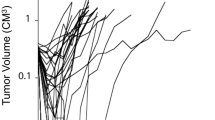Abstract
Dose-intensive chemotherapy regimens have entered clinical trial based on the notion that log-linear tumor-cell killing, especially with antitumor alkylating agents, is maintained at higher drug doses. Several clinical trials employing two intensifications are underway. Using the tumor-cell survival assay, animals bearing the FSaII fibrosarcoma were treated with single doses of various chemotherapeutic agents once or twice with a 3-or7-day interval between the drugs. Isobologram methodology was used to determine if the sequential treatment regimens resulted in subadditive, additive or greater-than-additive tumor-cell killing. When melphalan was followed 3 or 7 days later by a second dose of melphalan there was evidence of resistance to the second dose of melphalan as indicated by subadditive tumor-cell killing. Melphalan followed 3 days later by cyclophosphamide (300mg/kg) produced greater-than-additive tumor-cell killing, however, when the interval was 7 days the resulting tumor-cell killing was subadditive. Melphalan followed 3 or 7 days later by thiotepa or carboplatin produced subadditive-to-additive tumor-cell killing. Adriamycin followed 3 days later by melphalan, cyclophosphamide, thiotepa, or carboplatin resulted in subadditive-to-additive tumor-cell killing by the combinations. These results indicate that sequential drug-intensive treatments may not optimize tumor-cell killing in vivo.
Similar content being viewed by others
References
Alvarez Sotomayor E, Teicher BA, Schwartz GN, Holden SA, Meno K, Herman TS, Frei E (1992) Minocycline in combination with chemotherapy or radiation therapy in vitro and in vivo. Cancer Chemother Pharmacol 30:377–384
Frei E III (1992) Pharmacologic strategies for high-dose chemotherapy. In: Armitage JO, Antman KH (eds) High-dose cancer therapy: pharmacology, hematopoietins, stem cells. Williams & Wilkins, Baltimore, pp 3–13
Frei E III, Antman KH (1993) Combination chemotherapy, dose, and schedule: section XV, principles of chemotherapy. In: Holland JF, Frei E III, Bast RC Jr, Kufe DW, Morton DL, Weichselbaum RR (eds) Cancer medicine Lea & Febiger, Philadelphia, pp 631–639
Frei E III, Teicher BA, Holden SA, Cathcart KNS, Wang Y (1988) Preclinical studies and clinical correlation of the effect of alkylating dose. Cancer Res 48:6417–6423
Frei E III, Holden SA, Gonin R, Waxman DJ, Teicher BA (1994) Antitumor alkylating agents: in vitro cross-resistance and collateral sensitivity studies. Cancer Chemother Pharmacol (in press)
Holden SA, Teicher BA, Frei E III (1993) Stable and transient cross-resistance and collateral sensitivity among antitumor agents (AA). Proceedings 84th Meeting of the American Association for Cancer Research. Orlando, Florida, 34: 268
Rice L, Urano M, Suit HD (1980) The radiosensitivity of a murine fibrosarcoma as measured by three cell survival assays. Br J Cancer 41 [Suppl 4]:240–245
Schabel FMJ, Trader MW, Laster WRJ, Wheeler GP, Witt MH (1978) Patterns of resistance and therapeutic synergism among alkylating agents. Antibiot Chemother 23:200–215
Teicher BA (1992) Preclinical models for high-dose therapy. In: Armitage JO, Antman KH (eds) High-dose cancer therapy: pharmacology, hematopoietins, stem cells. Williams & Wilkins, Baltimore, pp 14–42
Teicher BA, Rose CM (1984) Perfluorochemical emulsion can increase tumor radiosensitivity. Science 223:934–936
Teicher BA, Holden SA, Jacobs JL (1987) Approaches to defining the mechanism of enhancement by Fluosol-DA 20% with carbogen of melphalan antitumor activity. Cancer Res 47:513–518
Teicher BA, Holden SA, Eder JP, Herman TS, Antman KH, Frei E III (1990) Preclinical studies relating to the use of thiotepa in the high-dose setting alone and in combination. Semin Oncol 17:18–32
Additional information
This work was supported by NIH grant PO1ßCA38493
Rights and permissions
About this article
Cite this article
Holden, S.A., Teicher, B.A., Ayash, L.J. et al. A preclinical model for sequential high-dose chemotherapy. Cancer Chemother. Pharmacol. 36, 61–64 (1995). https://doi.org/10.1007/BF00685733
Received:
Accepted:
Issue Date:
DOI: https://doi.org/10.1007/BF00685733




